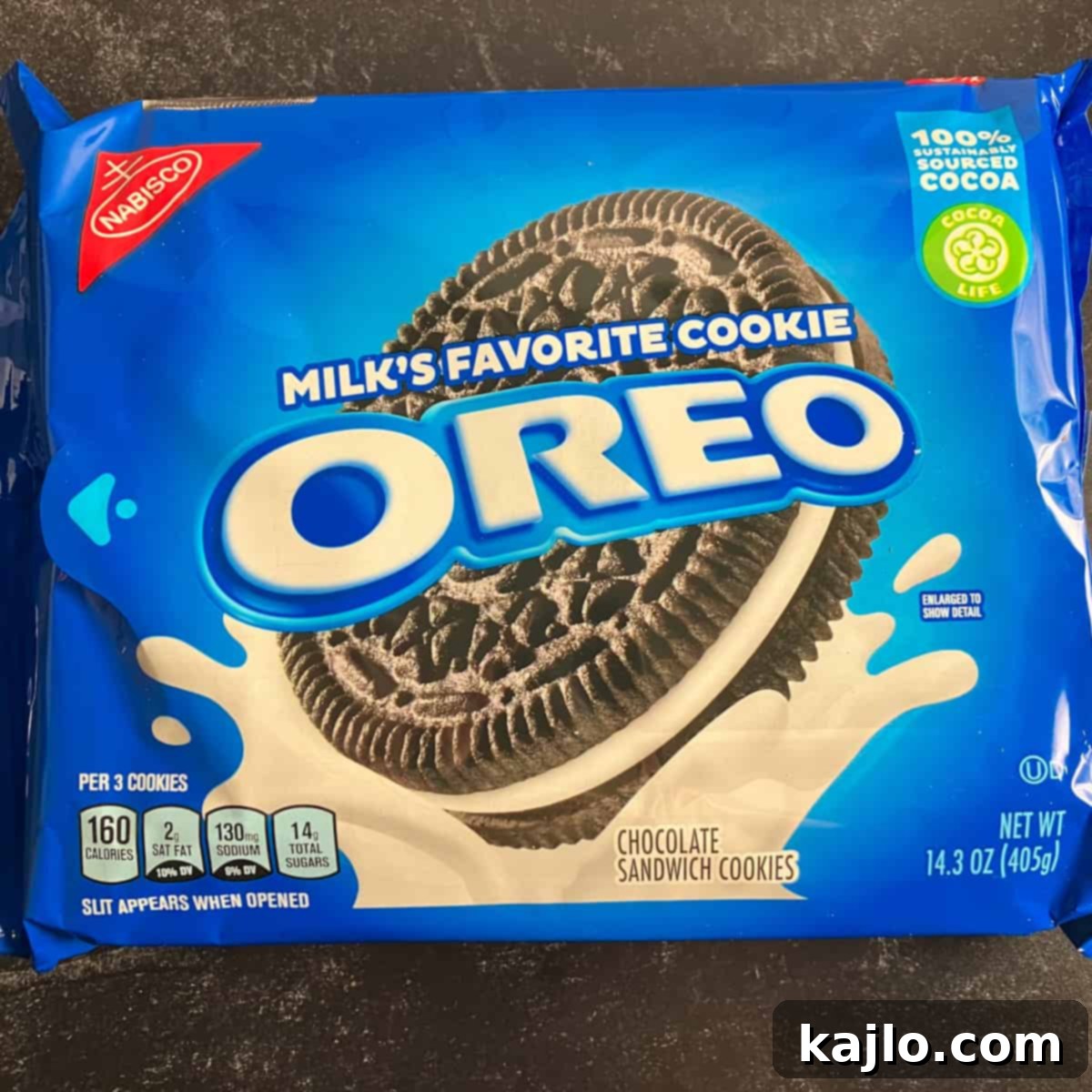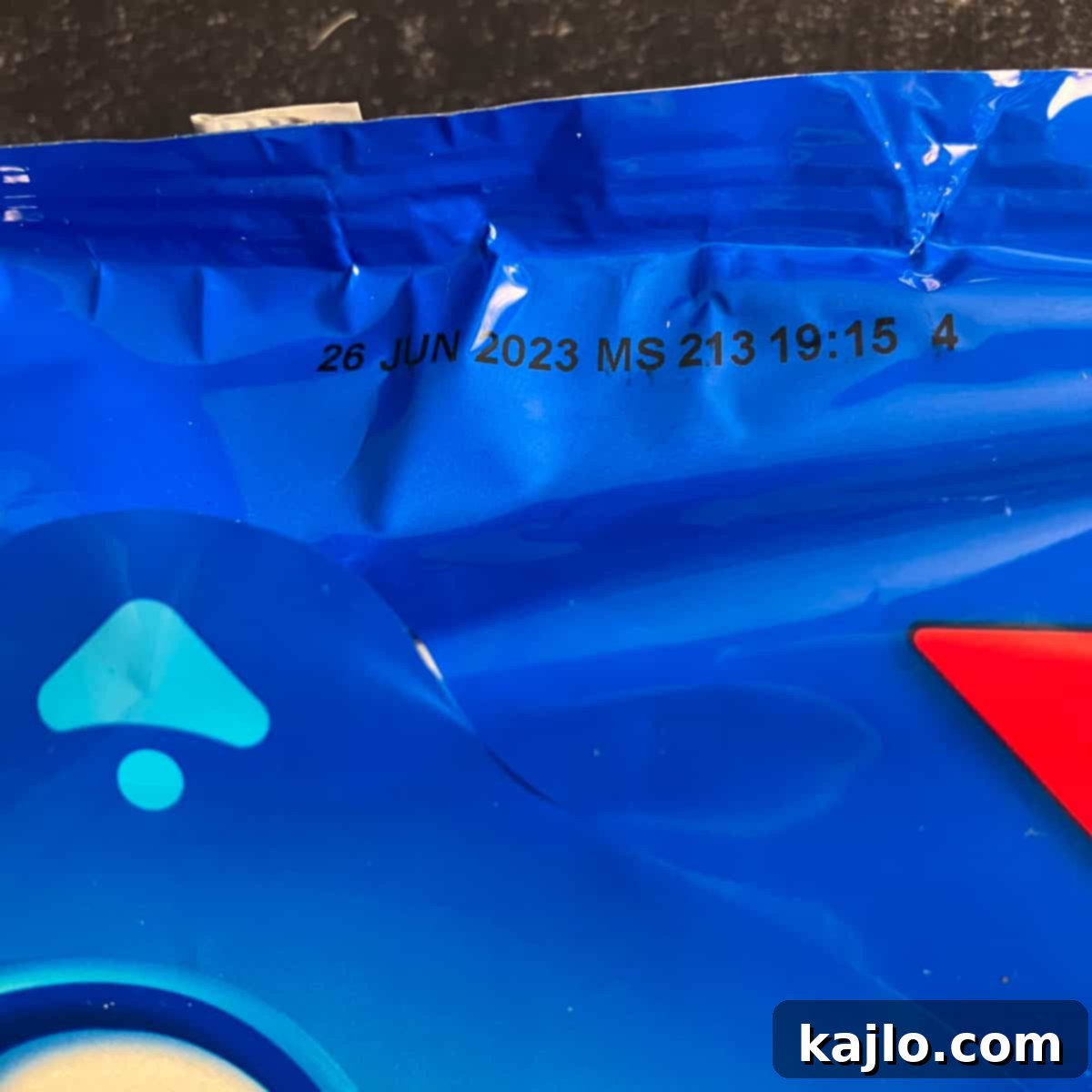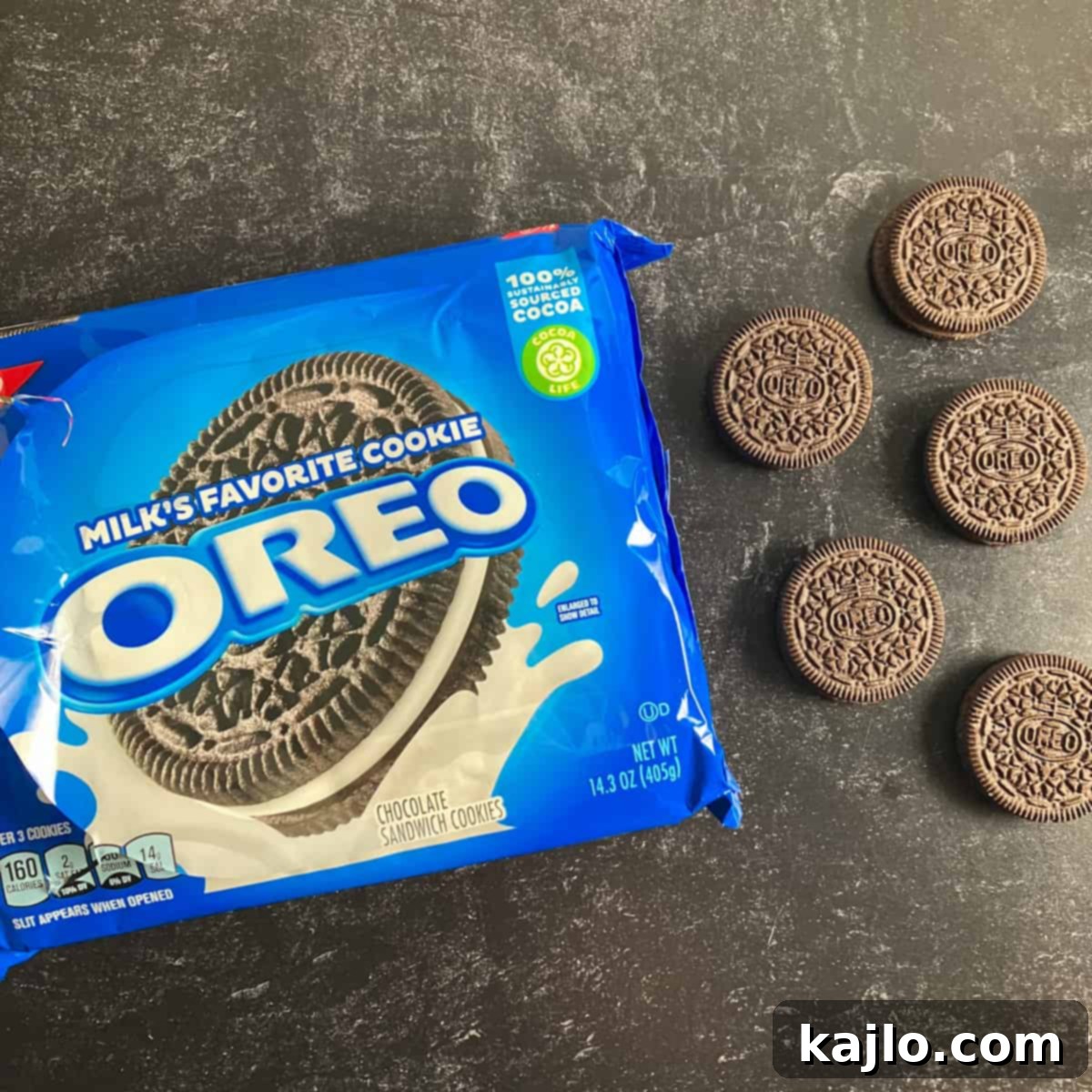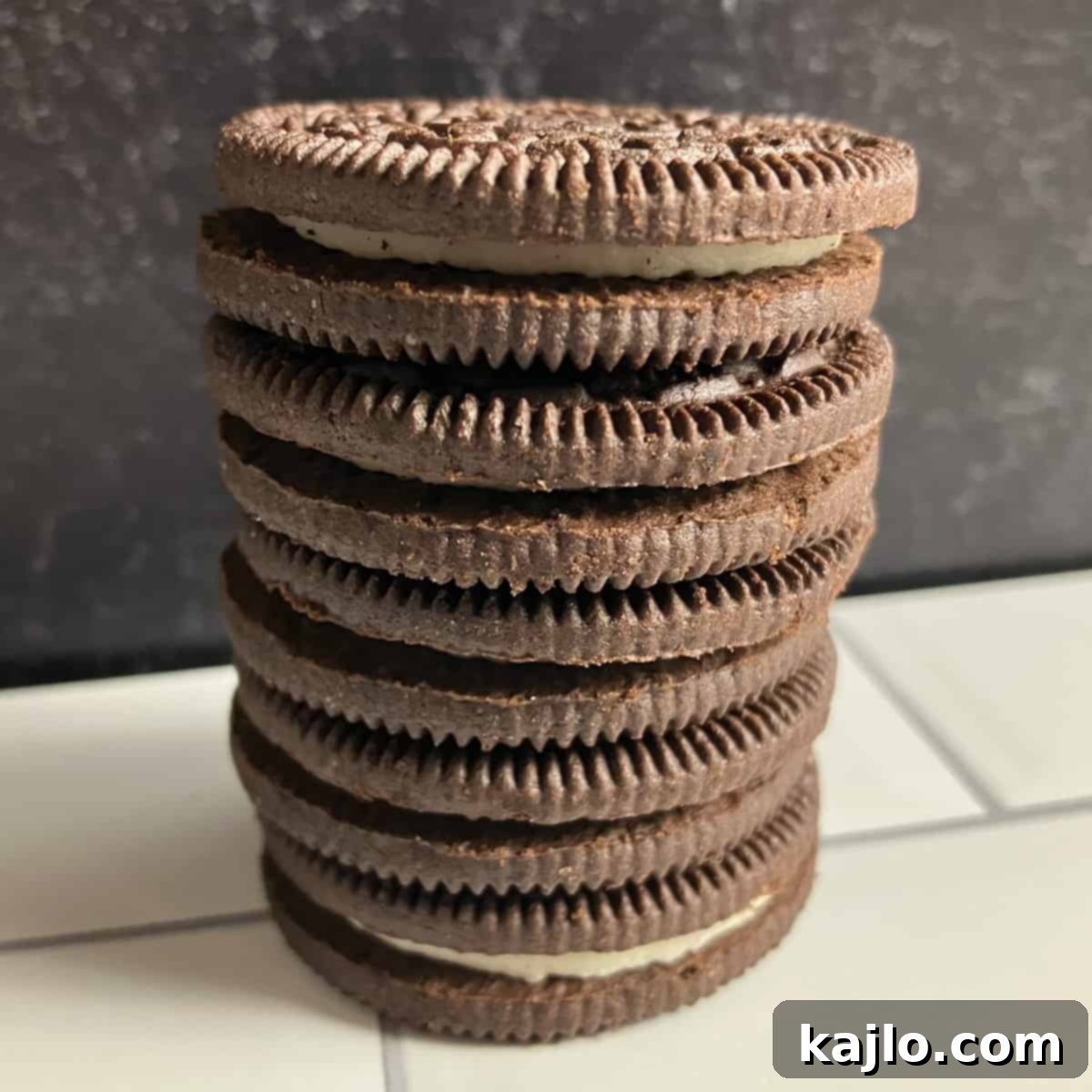Do Oreos Expire? Understanding “Best By” Dates and Shelf Life
A common question among snack enthusiasts is: Do Oreos expire? While Oreos are often considered a non-perishable food, the packaging always features a “best by” date. However, this date doesn’t signal when the cookies become unsafe to eat, but rather when they are at their peak for taste and texture. Understanding the difference between “best by” and “expiration” is crucial for enjoying your favorite sandwich cookies safely.
Technically, Oreos can “go bad” in the sense that their quality degrades over time. Expired Oreos might develop an off-smell, a strange taste, or an unpleasant texture. This article will delve into the nuances of Oreo shelf life, how to store them effectively, and what to do if you suspect your Oreos have truly expired.

Understanding the Shelf Life of Unopened Oreos
Many wonder, “Do Oreos go bad if not opened?” The simple answer is yes, they can, but their shelf life is remarkably long. Oreos are considered a shelf-stable product, meaning they can be stored at room temperature without refrigeration for extended periods. This is due to their low moisture content and the presence of preservatives that inhibit microbial growth. The robust packaging also plays a significant role in maintaining their freshness by protecting them from air and moisture.
However, “shelf-stable” doesn’t mean “indefinite.” Like any packaged food, Oreos can eventually succumb to spoilage if conditions aren’t ideal. If the packaging is compromised—torn, punctured, or exposed to excessive moisture—the cookies are vulnerable to staleness, mold growth, or absorption of off-flavors from the environment. Proper storage is paramount to ensure your unopened Oreos remain in optimal condition.
To maximize the lifespan of your unopened Oreos, always store them in a cool, dry place, such as a pantry or cupboard, away from direct sunlight or sources of heat. Keeping them in their original, sealed packaging is usually sufficient. However, for added protection, you might consider placing the entire package inside an airtight container or a heavy-duty Ziplock bag, especially if you anticipate storing them for several months.
How Long Do Unopened Oreo Cookies Really Last?
For Oreo enthusiasts, knowing the true longevity of their favorite cookies is key. If kept unopened and stored correctly, Oreos can typically last for a few months beyond the “best by” date printed on the package. This date is merely an indicator of peak quality, not food safety.
According to the FoodKeeper app, a helpful resource from Foodsafety.gov, unopened, store-bought crispy cookies can maintain their quality for up to 4-6 months when stored in the pantry. However, many consumers report enjoying unopened Oreos well past this timeframe, sometimes up to a year, provided there are no signs of spoilage. For an even longer duration, you can freeze unopened Oreos, where they can retain their optimal taste and texture for 8-12 months. This method essentially puts the aging process on hold, allowing you to enjoy fresh-tasting cookies much later.
Commercial data for Oreos designed for food service often indicates a total shelf life ranging from 210 to 270 days, which translates to approximately 7 to 9 months. This aligns with the general consensus that these cookies are designed for extended pantry storage. Always conduct a quick sensory check before consuming cookies past their “best by” date.
Locating the “Best By” Date on Your Oreo Package
Identifying the “best by” or “use by” date on an Oreo package can sometimes be a scavenger hunt. This date, an estimate of when the cookies will be at their freshest, is usually found on the side, bottom, or flap of the package. It’s often printed in small, discreet type, which can make it challenging to locate.
For example, on a recent purchase, the date was barely visible on the edge of the crimped seal, indicating a period approximately three months into the future. You might need to look closely and even unfold some packaging edges to find it. This date is crucial for understanding the manufacturer’s recommendation for optimal quality, but remember, it’s not a strict expiration date that dictates food safety.

How Long Are Oreos Good After Their “Best By” Date?
The “best by” date is about quality, not safety. You can generally still enjoy your Oreos even if they are a few weeks or even months past this date, provided the packaging remains intact and there are no visible signs of spoilage. The duration for which Oreos remain good after the package date largely depends on storage conditions and whether the package has been opened.
However, it’s important to understand that the quality—specifically the crunchiness and flavor intensity—will gradually diminish. They may become stale, lose their distinctive chocolate flavor, or the cream filling might harden. If you notice any definitive signs of spoilage, such as mold, a strange odor, or a noticeably rancid taste, it’s always safest to discard them.
Oreo “Best By” Date Format Explained
The format of the “best by” date on your Oreo package can vary by region or manufacturer. Common formats include month/day/year (e.g., 05/30/2023) or day-month-year. Some international products might even use a coded format that requires a quick online search or contacting customer service to decode. For instance, my Oreos listed the date in a day-month-year format, followed by additional batch and manufacturing time information. This additional data is crucial for traceability, especially in the rare event of a product recall.
If you’re ever uncertain about the date format or how to interpret it, the best course of action is to reach out to Oreo customer service. They can provide specific guidance based on the packaging details, ensuring you have the most accurate information regarding your cookies’ freshness.
Can Expired Oreos Make You Sick? Separating Myth from Reality
The question of “Can you eat expired Oreos?” often causes concern. While a “best by” date signifies optimal quality, truly spoiled Oreos can indeed lead to food poisoning. Consuming food that has genuinely gone bad, whether it’s Oreos or any other item, can result in uncomfortable symptoms such as nausea, vomiting, stomach cramps, diarrhea, and even fever.
It’s crucial to reiterate that the date on the Oreo package is typically a “best by” date, not a strict expiration date like that found on perishable goods. Therefore, an Oreo past its “best by” date isn’t automatically dangerous. However, if your Oreos display clear signs of being “expired” in the true sense of spoilage—such as visible mold, a distinctly off-putting taste or smell, or the cookie part becoming uncharacteristically soggy and losing its crunch—you should absolutely avoid eating them. Your senses are the most reliable tool for determining if your Oreos have spoiled, far more so than the “best by” date alone.
Slightly stale Oreos, which haven’t developed any of the aforementioned spoilage indicators, are likely safe to consume, though their enjoyment factor might be reduced. Since the primary purpose of eating Oreos is pleasure, you might prefer to purchase a fresh package. Alternatively, to prevent food waste, slightly stale cookies can be ingeniously repurposed. Crushing them into crumbs and adding them to vanilla ice cream, milkshakes, or using them as a crust for cheesecakes can revive their appeal and make for a delicious treat.
Do Oreos Mold?
While relatively rare due to their low moisture and high sugar content, Oreos are indeed susceptible to mold growth, especially if they are not stored correctly. Mold thrives in moist, warm, and stagnant air environments. If Oreos are exposed to humidity or air for prolonged periods, the high sugar content, which usually acts as a preservative, can paradoxically become a breeding ground for various molds and bacteria once moisture is introduced.
Preservatives in Oreos are designed to extend their shelf life and prevent premature mold growth, provided they are stored in a cool, dry place. Therefore, even if your Oreos are past their “best by” date, they might still be safe to eat as long as there are no overt signs of mold or other spoilage. Regularly inspect cookies that are older or have been exposed to air.
If you encounter moldy Oreos, it is imperative to discard them immediately. Consuming moldy food can pose significant health risks, potentially leading to allergic reactions, respiratory problems, or other adverse health issues depending on the type of mold and individual sensitivity. When it comes to mold on food, the adage “when in doubt, throw it out” is always the safest approach.
What Do Truly Expired Oreos Taste Like?
When Oreos genuinely expire and spoil, their taste profile changes dramatically and unpleasantly. Instead of the familiar sweet chocolate and cream, truly expired Oreos will likely taste stale, bland, or even rancid. The chocolate wafers might lose their crispness and become soft or cardboard-like, while the cream filling could become hard, crumbly, or develop an oily, off-flavor. A rancid taste is particularly concerning, as it indicates that the fats in the cookies have oxidized, potentially making them unsafe to eat.
Such a pronounced degradation in taste and texture means the cookies are no longer enjoyable and should not be consumed. It’s always best to err on the side of caution: if your Oreos taste distinctly “off,” dispose of them and purchase a fresh package to ensure a satisfying and safe snack experience.
Maximizing Freshness: How to Keep Opened Oreos Fresh
Once you open a package of Oreos, their exposure to air and moisture begins to accelerate the staleness process. To preserve their delightful taste and crisp texture, proper storage is crucial. The goal is to minimize air exposure and maintain a stable, dry environment.
The most effective method for keeping opened Oreos fresh is to transfer them from their original packaging to an airtight container. Options include plastic food storage containers with secure lids, glass jars with tight seals, or even heavy-duty Ziplock bags from which excess air has been pressed out. These barriers prevent moisture absorption and keep ambient odors from tainting your cookies. Store these containers in a cool, dry pantry or cupboard, away from direct sunlight and heat sources like ovens or stovetops. Avoid storing Oreos in humid environments, such as above a kettle or near a sink, as moisture is the primary enemy of crispy cookies, leading to rapid staleness.

How Long Do Oreos Last in the Fridge?
While not strictly necessary, refrigerating opened Oreos can slightly extend their shelf life beyond typical pantry storage. Generally, Oreos stored in a pantry after opening might last a few weeks before noticeably losing quality. In the refrigerator, they can potentially stay fresh for a month or even longer, depending on the conditions. The cooler temperatures slow down the aging process and inhibit microbial growth.
However, the key to successful refrigeration is preventing moisture. Always place the cookies in an airtight container before storing them in the fridge. This protects them from condensation and humidity inside the refrigerator, which can otherwise lead to soft, soggy Oreos. Without proper sealing, they can also absorb odors from other foods, altering their taste. Make sure the container is completely sealed to maintain their crispness and flavor.
How Long Do Oreos Last in the Freezer?
For those looking to significantly extend the shelf life of their Oreos, freezing is an excellent option. When properly frozen, Oreos can last an impressive 6 to 12 months, or even longer, while retaining their quality. This method effectively halts the aging process, keeping the cookies fresh for enjoyment far into the future.
To freeze Oreos, place them in a freezer-safe airtight container or a heavy-duty freezer bag, making sure to remove as much air as possible to prevent freezer burn. When you’re ready to indulge, simply remove the desired number of cookies from the freezer and let them thaw at room temperature for a few minutes. Many people even enjoy eating Oreos straight from the freezer for a different textural experience. Properly frozen and thawed Oreos will be nearly as good as fresh ones, making this a fantastic way to stock up during sales or prevent waste.
Frequently Asked Questions About Oreos and Expiration
Can Chocolate Covered Oreos Go Bad?
Yes, chocolate-covered Oreos can go bad just like regular Oreos. The chocolate coating, while offering an extra layer of protection, can also make it harder to visually detect spoilage. However, you should still look for signs such as discoloration in the chocolate (e.g., white bloom, which is often harmless fat bloom but can indicate age), a filmy appearance, or any strange, uncharacteristic odor. If any of these signs are present, it’s best to discard them.
Can I Eat 3-Year-Old Oreos?
While Oreos don’t have a strict expiration date, quality significantly deteriorates over time. If you discover a package of Oreos that is three years old, it’s highly advisable to avoid eating them. Even if they don’t show visible mold, they will almost certainly be very stale, lacking flavor, and potentially have a rancid taste from oxidized fats. While they might not cause immediate harm, they won’t be enjoyable, and the risk of an upset stomach increases. It’s best to replace them with a fresh package.
Are Expired Oreos Safe to Eat?
Whether “expired” Oreos are safe to eat depends entirely on what you mean by “expired.” If you mean past their “best by” date but showing no signs of spoilage, they are generally safe, though their quality might be diminished. However, if you mean Oreos that exhibit clear signs of true spoilage—such as visible mold, unusual smells, discoloration, or a distinct off-taste (like rancidity or sourness)—then absolutely not. Consuming genuinely spoiled Oreos significantly increases the risk of foodborne illness, especially if the package was opened or stored improperly, exposing them to contaminants. Always prioritize your safety and use your senses as your primary guide.
How Bad Are Oreos for You? A Look at Their Nutritional Profile
Oreos, while undeniably delicious, fall into the category of ultra-processed foods. They are relatively high in sugar and fat, and low in essential nutrients like fiber, vitamins, and minerals. While not the healthiest snack choice, they can certainly be enjoyed as an occasional treat as part of a balanced diet that emphasizes whole, unprocessed foods. Moderation is key.
A standard serving of Oreos (typically 3 cookies) provides a notable amount of calories, fat, and sugar. Below is a general nutritional breakdown:
| Nutrient | Amount per Serving (3 cookies) |
|---|---|
| Calories | 160 |
| Total Fat | 7g |
| Saturated Fat | 2g |
| Trans Fat | 0g |
| Cholesterol | 0mg |
| Sodium | 135mg |
| Total Carbohydrate | 25g |
| Dietary Fiber | 1g |
| Total Sugars | 14g |
| Protein | 1g |
Beyond the macronutrients, Oreos contain ingredients like “wheat flour” (which is refined white flour, not whole wheat), high fructose corn syrup, and artificial flavor. While it’s a common misconception, Oreos are technically dairy-free and suitable for vegans, which is a consideration for those with dietary restrictions. However, this fact doesn’t elevate them to a “health food” status; they remain an indulgent treat.
Nutritional profiles for various Oreo flavors like Mint Oreos, Birthday Cake Oreos, and others are generally quite similar to the original. Oreo Thins offer a slightly different proposition, providing a greater number of cookies per serving for roughly the same caloric intake, owing to their smaller size.
More Cookie Delights and Information
Cookies are a beloved treat enjoyed worldwide in countless forms. If you’re passionate about cookies and eager for more content, explore these additional resources:
- Pizza Hut Cookie Dough: A Sweet Indulgence
- Biscoff Butter Cookies: A Guide to the Iconic Treat
- Cookie Monster Cookies: Fun & Delicious Recipe
- Air Fryer Sugar Cookies: Quick and Easy Baking
- Dairy-Free Chocolate Chip Cookies: A Delightful Alternative
Important Disclaimer
The information provided on this website is for general informational purposes only and does not constitute medical or nutritional advice. It may or may not be appropriate for your specific health needs or personal preferences. Always consult with a qualified healthcare professional, such as a registered dietitian or your physician, to determine the dietary patterns or health strategies that are best suited for your individual circumstances.
Any nutritional information presented, such as calorie counts or nutrient breakdowns, is an estimate provided as a courtesy. These figures can vary significantly based on the specific brands of ingredients used, preparation methods, and other factors. Please be aware that calorie information on food labels can sometimes be inaccurate, and minor variations should not be a cause for excessive concern. Focus on overall dietary balance rather than fixating on precise numbers.
Stay connected with our community! Subscribe to receive the latest and greatest recipes, and follow us on Facebook, Pinterest, Instagram, and YouTube!
